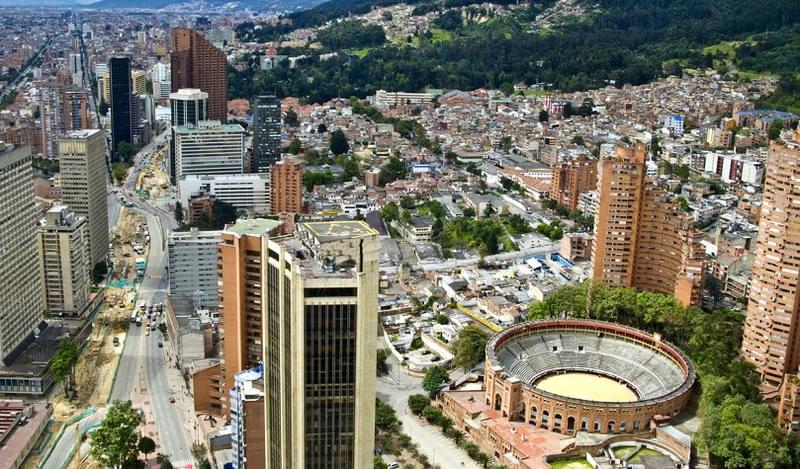Colombia is one of Latin America’s largest countries with a population of around 40 million people, and the continent’s fourth largest economy. The country also has extensive cultural and economic links with Central America, which as a whole has a population similar to Colombia’s.
That’s why when large international banks retreated from the region almost a decade ago, Colombian lenders saw an exciting opportunity to expand their operations, enabling some to nearly double their regional market share by buying large or majority stakes in some of Central America’s top lenders.
The result of these endeavours was impressive. In just a few years, Colombian groups have managed to take control of 53% of the financial system of El Salvador, 25.5% of Panama's, 21% of Costa Rica’s.
The move seems to have been quite prescient. While GDP growth in many of Latin America’s larger economies seems to be stalling (or reversing) due to one or some combination of stagnation, fiscal mismanagement, or corruption-induced arrested development, Central American economies seem to be consistently putting in 4% and 7%.
This sudden expansion has also bolstered the financial sector’s role in the Colombian economy, too; since 2014, financial institutions have accounted 4.9% of the country’s GDP.
The Shopping Spree Begins
Bancolombia was the first financial institution to take the leap, when in 2007 it acquired El Salvador’s largest bank, Banco Agricola. It then went on to acquire 60% of BAM Guatemala in 2012 and HSBC Panama, for US$2.23bn – the highest amount paid for a single bank in the region. About 35% of Bancolombia’s total revenues are derived from its international operations.
Alejandro Mejia, Manager of Investor Relations at Bancolombia, explained that Central America was a natural next step for many Colombian companies looking for regional expansion opportunities.
“Bancolombia became a pioneer in Central America because we believed that many of the financial services we offer in Colombia were transferable to this region,” Mejia explains, adding that the move – in the works for nearly a decade – is paying healthy dividends.
“So far, we have seen very positive results, and today the group has four important operations – in Colombia, Panama, El Salvador and Guatemala. This has not only helped us improve our services in general. Through this expansion, we have been able to diversify the risks of Bancolombia between different countries”.
Integration – and particularly, the ability to transplant expertise and best practice – was an enormous undertaking, but the company’s strategy of importing these from its Colombian operations seems to be working well, Mejia says.
Today, Bancolombia’s stake in Central America is impressive. Its strongest position is in El Salvador, where the group controls 37% of the market, followed by Guatemala and Panama, where it has a 14% and 10% slice of the market, respectively.
“In a few years, our expansion has enabled us to offer our clients a wider diversity of products.”
Bancolombia may have been the first to dive into the Central American region, but others caught on quickly.
Grupo Aval, a huge Colombian holding company and parent of Banco de Bogota, acquired BAC Credomatic’s operations in 2012; at the time of the acquisition, the bank operated in all six of Central America’s major economies. The company continued its shopping spree in 2013 when it acquired the whole of BBVAs Panama operations for US490mn.
Today, Grupo Aval has a net worth of US$2bn in Central America and employs roughly 25,000 people.
Alejo Sanchez, Manager of Financial Planning and IR at Grupo Aval, explained that the decision to expand into Central America was not taken lightly.
“Central America was a region we had been looking at for a long time. First, because the size was similar to Colombia’s - it has a lot of growth potential because most of these countries have weak banking coverage. There are also strong cultural similarities between the region and Colombia."
“BAC Credomatic seemed like the perfect opportunity because it already had an integrated regional operation, and we didn’t need to engineer any bold turnaround – it was already performing fairly well,” Sanchez explained.
“Since the acquisition, we have more than doubled our operations in the region, and our revenues went from US$15mn in 2010 to more than US$300mn in 2016. We have become relevant players in all the markets in which we have presence,” he adds.
Costa Rica, Panama, and Guatemala represent 70% of the regional operations of Grupo Aval, while Honduras, Nicaragua and El Salvador account for the remaining 30%.
Davivienda followed Grupo Aval and Bancolombia into the region, acquiring the operations of HSBC in Costa Rica, Honduras, and El Salvador, for roughly US$800mn.
Not every transaction has been equally successful. According to Moody’s, Bancolombia, thanks in large part to Panamanian and Guatemalan trade, has been the biggest beneficiary of the gambit so far, with annual revenues at Banistmo (formerly HSBC) growing by roughly 20%, similar to levels seen by BAM in Guatemala.
Davivienda has seen its subsidiaries in Central America grow a mere 1%, while BAC Credomatic, which has a similar number of banks dotted throughout the region, has produced more revenues than Bancolombia and Davivienda combined.
Growing pains are a natural part of the process, particularly during the integration phase.
“For us, it has been a learning process gaining an understanding of each country’s laws, because even though we have a regional strategy we understand we need to adjust to needs of each state,” Mejia explained.
“The major hurdles we encountered were of a regulatory nature… Before the acquisition, BAC was a very well-managed institution. We were able to maintain the key management stakeholders, which made the transaction much easier,” Sanchez mentioned.
How Colombian banks saliently became dominant players in the Central American financial sector will surely be followed for years to come, particularly as other large international lenders mull divestment throughout Latin America. Crucially, these firms’ relative success in the region could create an added incentive for other Colombian corporates to make inroads into Central America – something that could drive deal flow as the region’s capital markets mature.









